/WITH YOU HERE BETWEEN
Leslie Schomp
ArtsWorcester Window Gallery
November 3 - December 18, 2022
Leslie Schomp’s stitched hair drawings are both objects of devotion and drawn illusions. Hair has a history of being a medium of commemoration and love. By pairing self portraits with images from nature, the artist emphasizes our place in the natural world through this humble medium. Her drawings serve as a love letter to all that nature is: heartbreaking, terrifying, awe-inspiring, nostalgic, and magical.
/ABOUT THE ARTIST

Leslie Schomp
I received my MFA from the Massachusetts College of Art and my BFA from Florida State University. I am senior lecturer who primarily teaches drawing in the Visual Arts department at the College of the Holy Cross, where I have taught since 2000. My home is in the country in Massachusetts. Landscape is a powerful visual in my everyday life. As a gardener I am struck by the heartache, fear, desire, violence and beauty of the natural world. My work consists of drawings and sculptures created with textiles. Each piece is an investigation into how I see myself as “part of” instead of “apart from” nature.
My stitched works were recently included in Threads: Contemporary Embroidery Art, by Charlotte Vannier, published by Thames and Hudson. This book featured the work of eighty international artists who use embroidery as their mode of expression. In 2008 and 2022 I was a finalist for the Massachusetts Cultural council artist grant in Drawing. Recent exhibitions include a 2020 solo exhibit at Fitchburg State University. I was an artist-in-residence at Fruitlands Museum in 2021 where I made a series of embroidered samplers using the written text of Louisa May Alcott from her childhood diary. This work was included in the group exhibit Artists and Language at Suffolk University Art Gallery this year.
Artist website: www.leslieschomp.com
/STATEMENT
My hair drawings are rooted in a tradition of using hair as a material that is humble, devotional, genetic and of “natural” origins. Images of the self and the natural world are displayed in found antique frames and grouped to create suggested stories and feelings. The frames emphasize both equality and individuality of each image. They also explore ideas about various states of the self and human psychology. This work is devoted to seeing myself as part of nature instead of apart from it. Victorian hair tokens and wreaths have long fascinated me as a source of inspiration. Hair itself, both sensual and disgusting, becomes a medium of tension. As a medium, it shows that a drawing can be both illusion and object.
/EXHIBITED WORKS
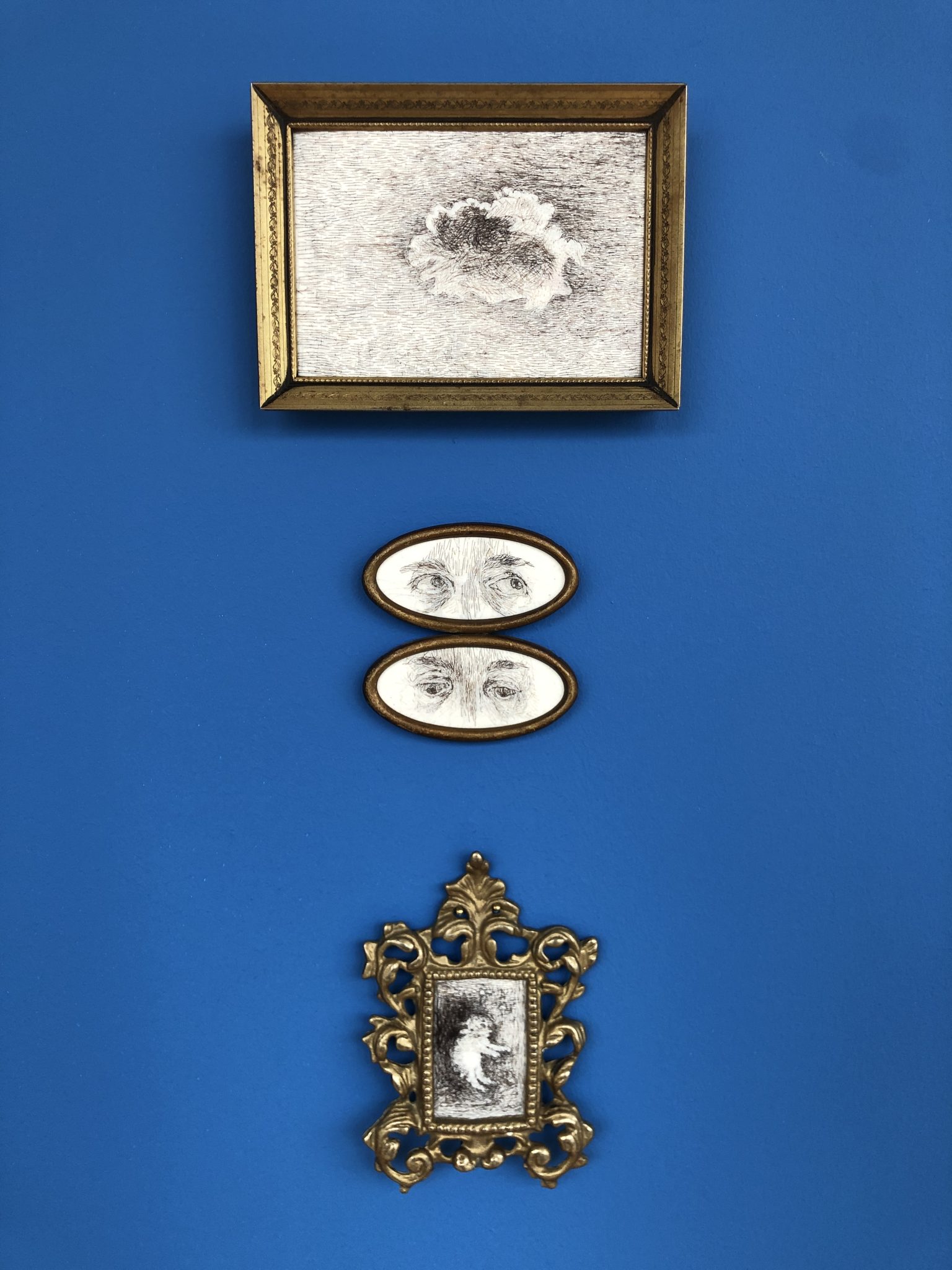
Cloud, Eyes, and Baby Rabbit
hair on cloth in found frames
2022
Ralph Waldo Emerson, from Nature
"Standing on the bare ground, - my head bathed by the blithe air and uplifted into infinite space, - all mean egotism vanishes. I become a transparent eyeball; I am nothing; I see all; the currents of the Universal Being circulate through me; I am part or parcel of God"
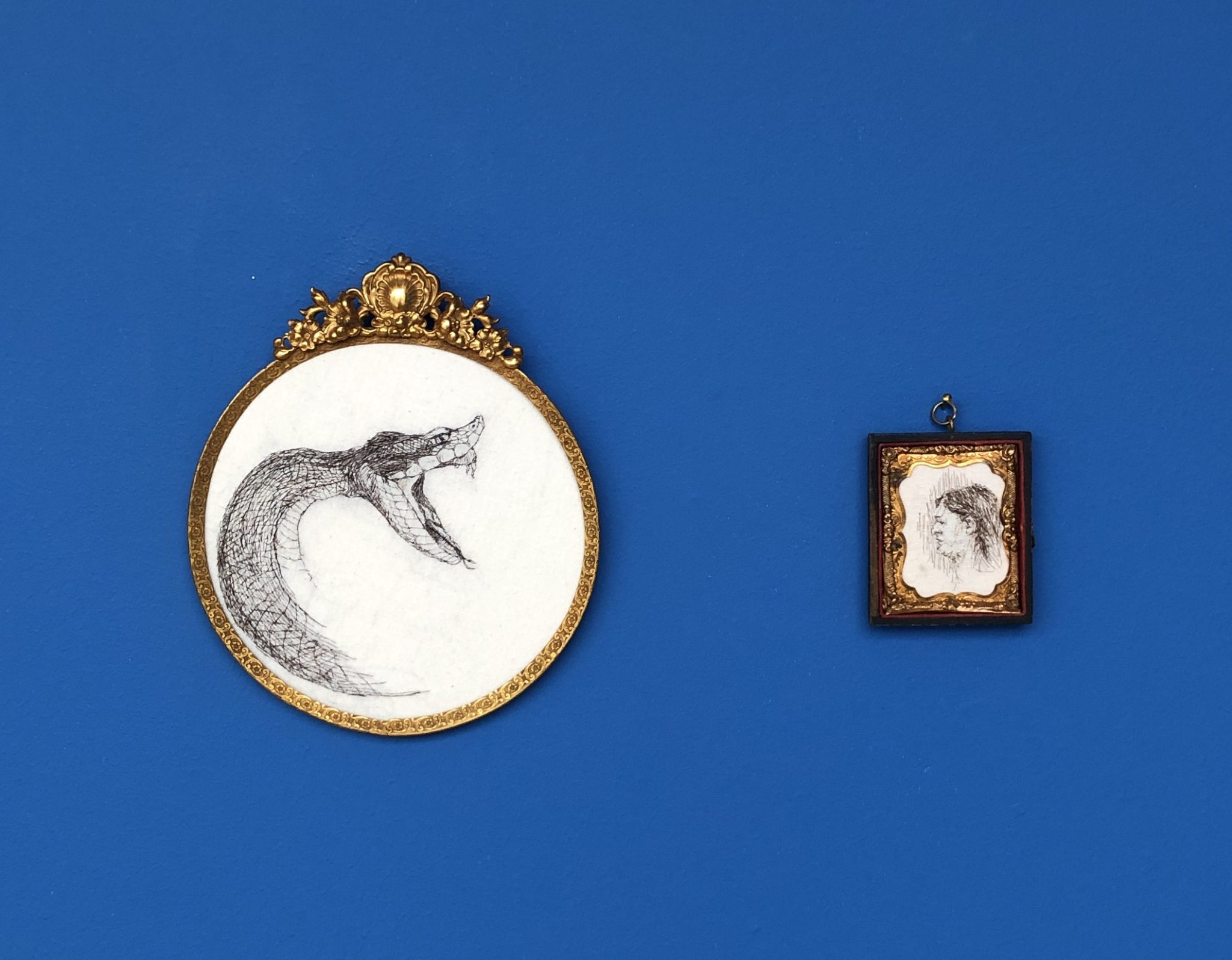
Self-Portrait with Snake
hair on cloth in found frames
2017 – 2022
Iris Murdoch, from The Sovereignty of Good
"Following a hint in Plato (Phaedrus 250) I shall start by speaking of what is perhaps the most obvious thing in our surroundings which is an occasion for ‘unselfing’, and that is what is popularly called beauty. Recent philosophers tend to avoid this term because they prefer to talk of reasons rather than of experiences. But the implication of experience with beauty seems to me to be something of great importance which should not be by-passed in favour of analysis of critical vocabularies. Beauty is the convenient and traditional names of something which art and nature share, and which gives a fairly clear sense to the idea of quality of experience amid change of consciousness. I am looking out of my window in an anxious and resentful state of mind, oblivious of my surroundings, brooding perhaps on some damage done to my prestige. Then suddenly I observe a hovering kestrel. In a moment everything is altered. The brooding self with its hurt vanity disappeared. There is nothing now but kestrel. And when I return to thinking of other matter it seems less important. And of course this is something which we may also do deliberately: give attention to nature in order to clear our minds of selfish care. It may seem odd to start the argument against what I have roughly labelled as ‘romanticism’ by using the case of attention to nature. In fact I do not think that any of the great romantics really believed that we receive but what we give and in our life alone does nature live, although the lesser ones tended to follow Kant’s lead and use nature as an occasion for exalted self-feeling. The great romantics, including the one I have just quoted, transcended ‘romanticism’. A self-directed enjoyment of nature seems to me to be something forced. More naturally, as well as more properly, we take a self-forgetful pleasure in the sheer alien pointless independent existence of animals, birds, stones and trees. ‘Not how the world is, but that it is, is the mystical’."
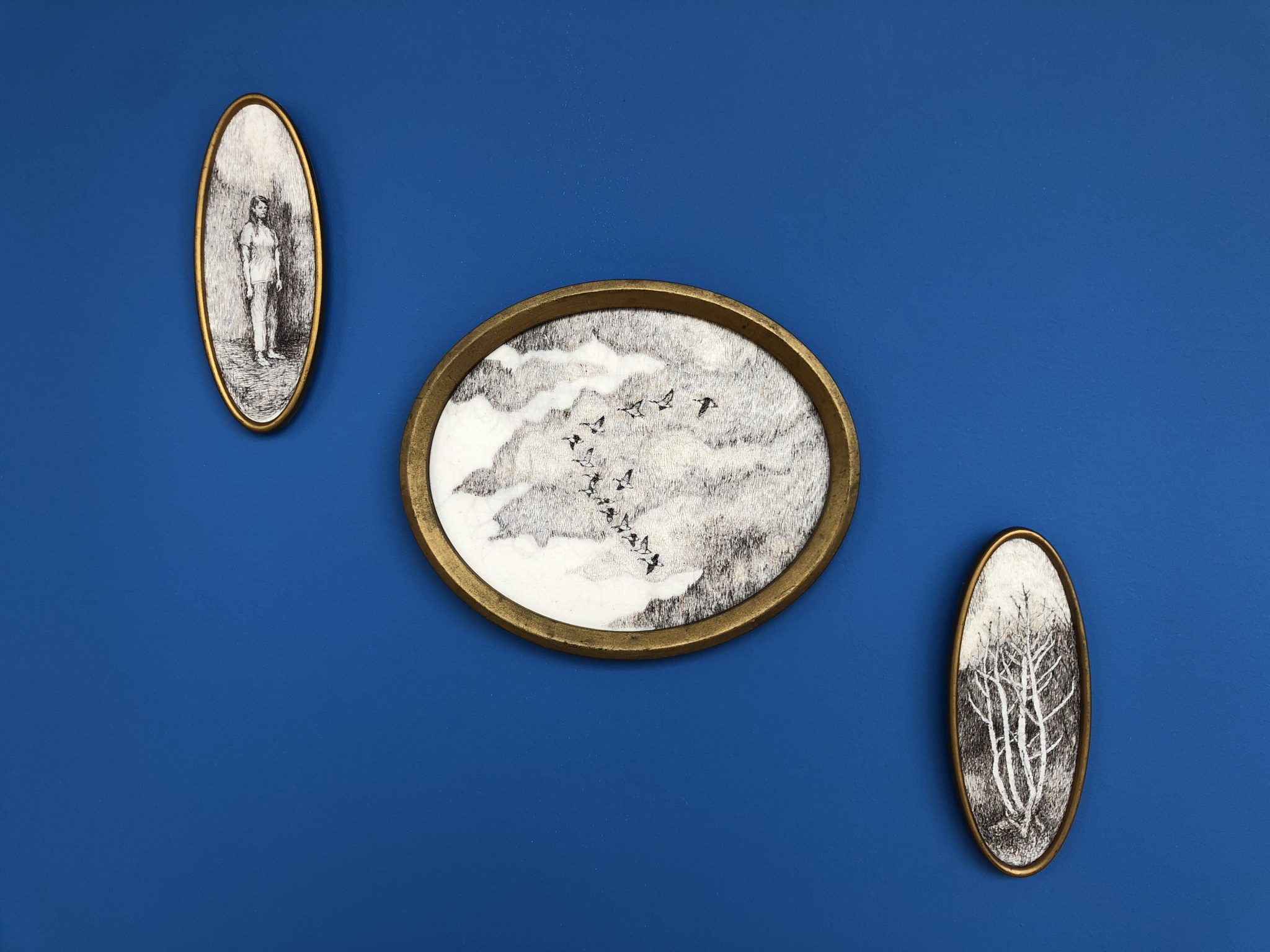
Self with Brothers’ Tree and Geese
hair on cloth in found frames
2022
Mary Oliver, from A Thousand Mornings
I go down to the Shore
I go down to the shore in the morning
and depending on the hour the waves
are rolling in or moving out,
and I say, oh, I am miserable,
what shall-
what should I do? And the sea says
in its lovely voice:
Excuse me, I have work to do.
Poem of the One World
This morning
the beautiful white heron
was floating along above the water
and then into the sky of this
the one world
we all belong to
where everything
sooner or later
is a part of everything else
which thought made me feel
for a little while
quite beautiful myself
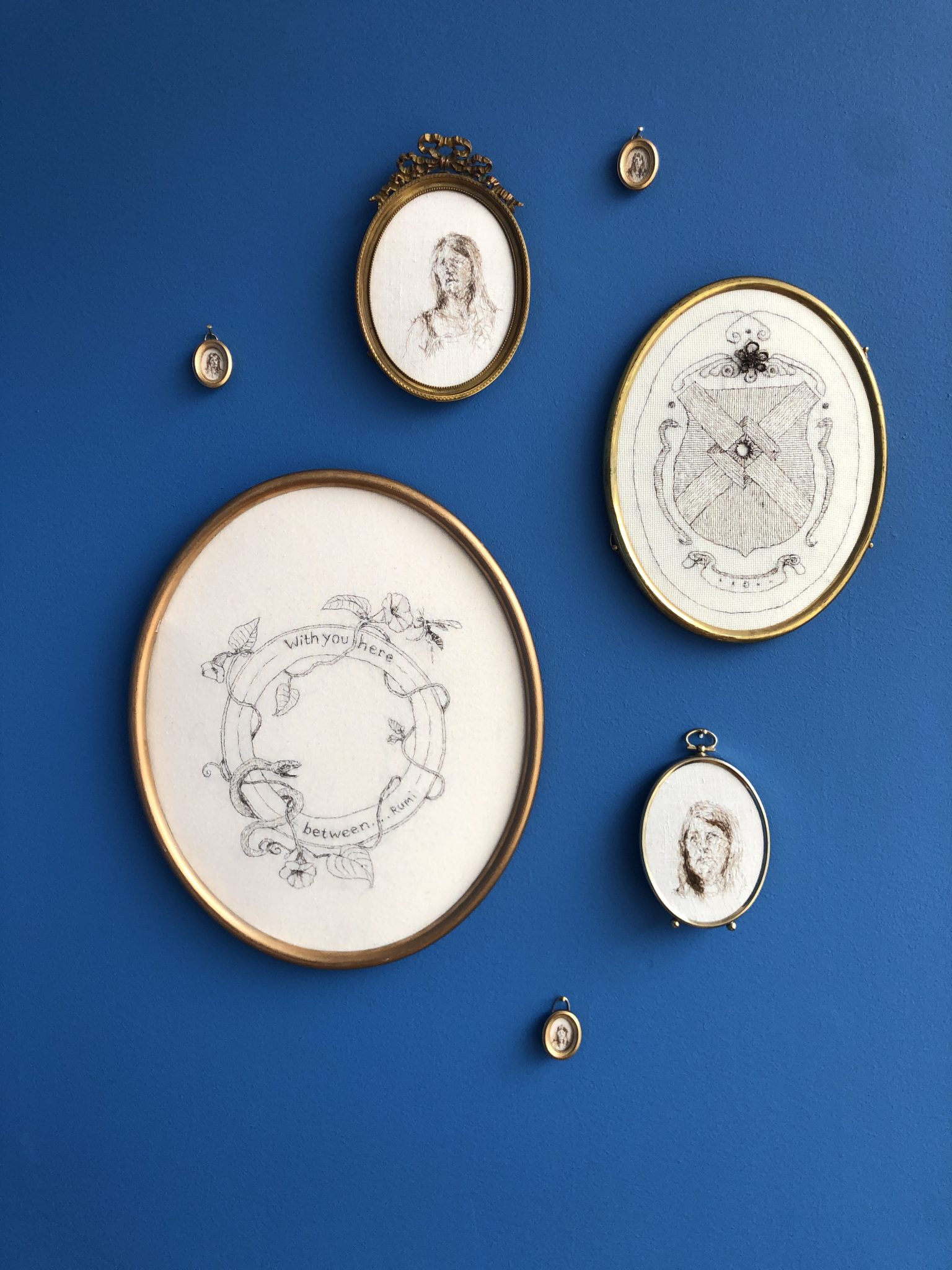
With You Here Between, Personal Coat of Arms, and Self-Portraits
hair on cloth in found frames
2012 – 2022
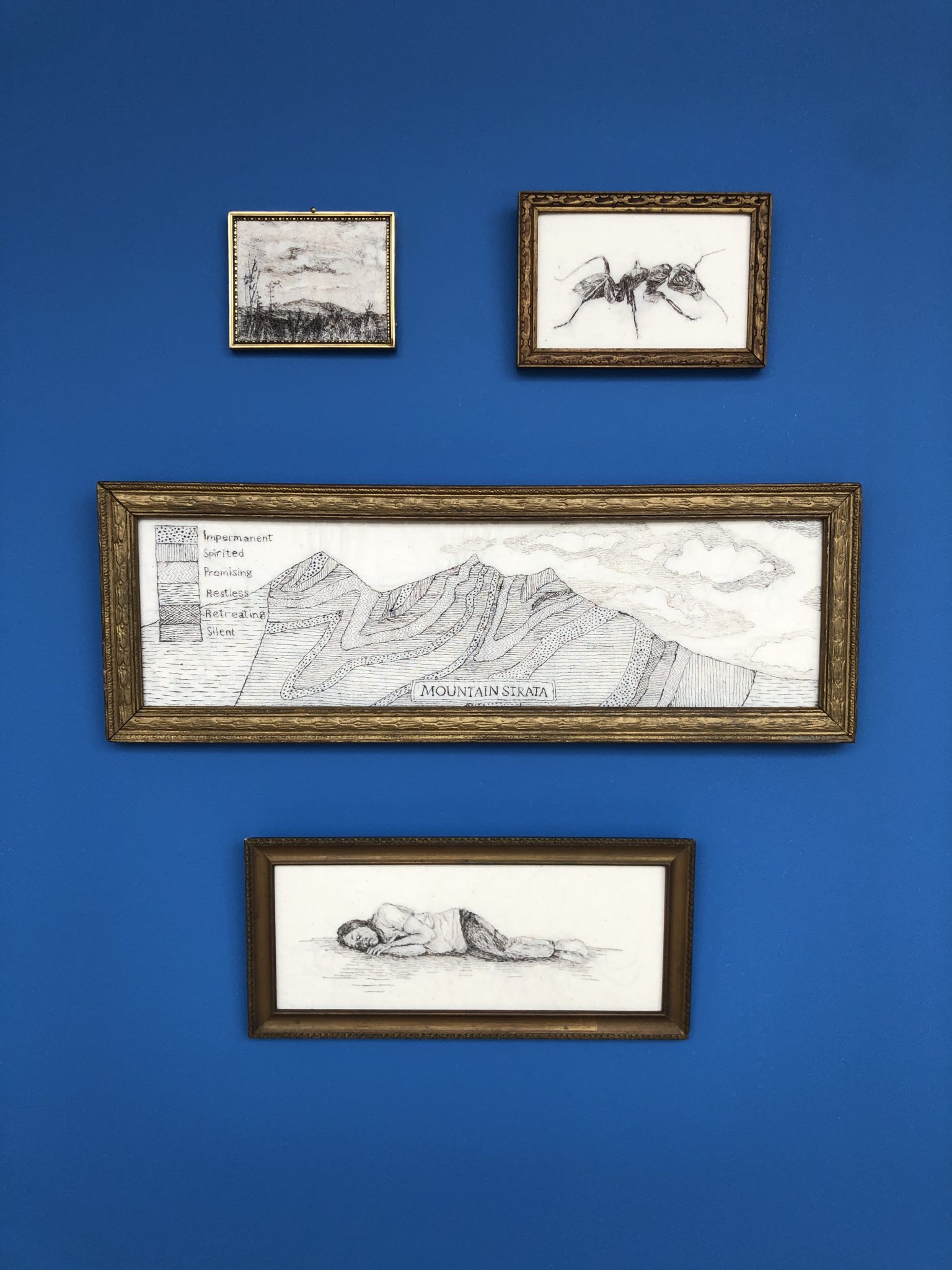
Daily View of Mt. Monadnock, Ant, Mountain Strata, and Self-Portrait
hair on cloth in found frames
2021 – 2022
Rebecca Solnit, from A Field Guide to Getting Lost
The world is blue at its edges and in its depths. This blue is the light that got lost. Light at the blue end of the spectrum does not travel the whole distance from the sun to us. It disperses among the molecules of the air, it scatters in water. Water is colorless, shallow water appears to be the color of whatever lies underneath it, but deep water is full of this scattered light, the purer the water the deeper the blue. The sky is blue for the same reason, but the blue at the horizon, the blue of the land that seems to be dissolving into the sky, is a deeper, dreamier, melancholy blue, the blue at the farthest reaches of the places where you see for miles, the blue of distance. This light that does not touch us, does not travel the whole distance, the light that gets lost, gives us the beauty of the world, so much of which is in the color blue.
For many years, I have been moved by the blue at the far edge of what can be seen, that color of horizons, of remote mountain ranges, of anything far away. The color of that distance is the color of an emotion, the color of solitude and of desire, the color of there seen from here, the color of where you are not. And the color of where you can never go. For the blue is not in the place those miles away at the horizon, but in the atmospheric distance between you and the mountains. ‘Longing’, says the poet Robert Hass, ‘because desire is full of endless distances’. Blue is the color of longing for the distances you never arrive in, for the blue world…
We treat desire as a problem to be solved, address what desire is for and focus on that something and how to acquire it rather than on the nature and the sensation of desire, though often it is the distance between us and the object of desire that fills the space in between with the blue of longing. I wonder something whether with a slight adjustment of perspective it could be cherished as a sensation on its own terms, since it is as inherent to the human condition as blue is to distance? If you can look across a distance without wanting to close it up, if you can own your longing in the same way you own the beauty of that blue that can never be possessed?
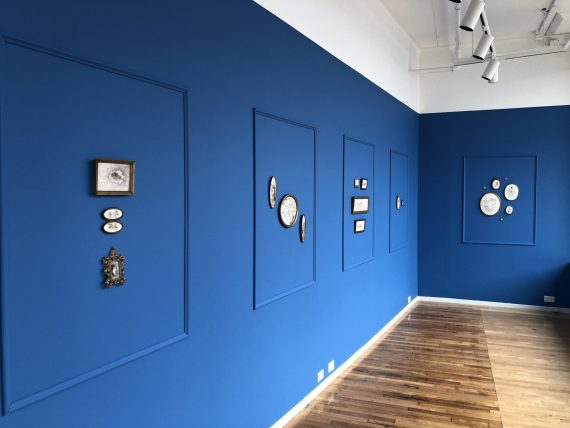
Robert MacFarlane, from The Wild Places
Edward Thomas was, from a young age, a walker, both by night and day. In his mid-twenties, when he was suffering from depression, he would often set off on long walking tours, alone, in the march-lands of Wales and England. Like so many melancholics, he developed his own rituals of relief, in the hope that these might abate his suffering, and that he might out-march the causes of his sadness.
We have in many ways forgotten what the world feels like. And so new maladies of the soul have emerged, unhappinesses which are complicated products of the distance we have set between ourselves and the world. We have come increasingly to forget that our minds are shaped by the bodily experience of being in the world- its spaces, textures, sounds, smells and habits- as well as by genetic traits we inherit and ideologies we absorb.
Never miss an exhibition or event.
Get updates when you sign up for ArtsWorcester emails.
